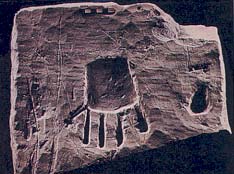Image Details

Courtesy William Dever
The hand of God? An enigmatic drawing accompanies an inscription that reads, “Blessed … by Yahweh … and his asherah” on the wall of an Iron Age II (1000–586 B.C.E.) tomb at Khirbet el-Kom, near Hebron. A similar inscription appears on an eighth-century B.C.E. sherd from Kuntillet Ajrud, in Sinai. Some scholars take these two inscriptions as evidence that at least some ancient Israelites believed that their God Yahweh had a female consort.
The el-Kom and Kuntillet Ajrud inscriptions, William Dever notes, serve as two parade examples of archaeology’s contribution to Biblical studies: They show that the cult of Asherah was widespread in ancient Israel, which explains why the cult was so frequently—and scathingly—criticized in the Bible.
